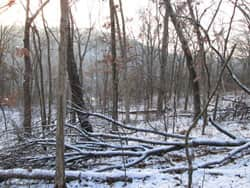Deer Hunting in Snow: Advantages and Disadvantages
In Search of Whitetails 01.16.13

The new year brought a priceless gift toward the end of this year’s bowhunting season: an inch of accumulating snow. This might not seem surprising for Missouri. An inch of snow is nothing! Yet after a record drought and a winter that (so far) has yielded less than 10% of the snowfall it should, I was grateful.
My managed bowhunt had about ten days left; I had two unfilled tags and a wife whose patience for bowhunting hadn’t quite run out. Plus, I needed a confidence booster after my missed buck opportunity a few days before.
Snow Hunting Advantages
A fresh snowfall brings many advantages to the deer hunter, particularly when hunting unfamiliar territory. This late in the season, the deer are warier than ever. We need every bit of help we can get!
Deer Tracks and Movement
 Buck tracks through a bedding area
Buck tracks through a bedding area
The most obvious advantage of new snowfall is that anything moving in it must leave tracks. Deer sign are easier to see, to follow, and therefore to interpret when made in new snow. Also, the timing of the snow tells you how recently the deer came through. If it snowed overnight and you find fresh tracks at sunrise, you know they were made by deer moving overnight or in the pre-dawn hours. Snow provides a complete snapshot of deer patterns and movement. In my managed hunt, I took advantage of this and discovered:
- New game trails. It’s just amazing how deer seem able to move through thick, low-hanging underbrush. Tracks indicated that a lot of deer entered fields in places where I didn’t even see a trail.
- Major deer highways. The complete survey of deer movement also led me to some hotspots where several sets of tracks converged. The most striking of these was a man-made trail connecting two fields separated by a ridge. There had to be 20 sets of tracks there, most of them moving west to east.
- Active food sources. Another hotspot revealed by the snow was a patch of tall, brown grass in the middle of a field. There were numerous sets of tracks, large and small, converging on it from several directions. From the timing, I knew that they were feeding here overnight which makes sense because the spot was so open.
Census of Other Hunters
Snow also offers the opportunity to survey your competition: predators of the two-footed and four-footed variety. When hunting public land, I try to hunt as far away from other hunters as possible. Knowing where others have their stands and what trails they take can help predict when deer might be bumped in your direction. Snow also lets me keep tabs on coyotes, the primary non-human predator of deer in Missouri.
Increased Visibility
A snow-covered landscape provides excellent contrast for spotting deer (and other animals) from afar. This served me well in my managed hunt, as I was able to spot a couple of slow-walking does in a field through timber from a good distance away. It’s even better with a pair of fogproof hunting binoculars. Of course, that visibility (and the crunch that snow makes when you walk on it) works both ways. I found that out when I tried to sneak down the ridge to intercept them — five steps and the does spooked. Noise seems to travel more readily across the frigid landscape.
Limited Food Sources
A good accumulating of snow makes it harder for animals to find food, especially ground browse such as nuts and acorns. Limited food options combined with higher energy requirements (presumably many deer lost weight during the rut) can create opportunities. In the case of my managed hunt, the deer were looking to browse on tall wheat-like grasses in agricultural fields, which were accessible after the snowfall.
Disadvantages of Snow Hunting
Though hunting in snow has its perks, there are some down sides to it as well. Namely:
- Cold weather. It takes below-freezing air and ground temperatures for snow to stick around. You really have to bundle up to stay warm, and all those layers can interfere with shooting a bow. Plus, walking on snow makes for cold feet no matter how many pairs of heavy wool socks you have on. My article on cold weather hunting strategies offers some tips for increasing your chances of success.
- Dangerous conditions. Snow makes things slippery, which is hazardous when you’re hunting uneven terrain. Be careful out there, and take extra time to navigate the slick spots. Snow can also conceal holes and other things you don’t want to step on.
- No hiding your own tracks. If you’ve got a secret trail or hunting spot, your tracks may leave other (less scrupulous) hunters right to it. Beware of that. It’s also reasonable to assume that deer will note a hunter’s tracks and use that information to avoid him.
Conclusion: Need More Snow to Hunt In
With consecutive years of below-average snowfall, I haven’t had much opportunity to hunt in the snow. Maybe one day out of the year. And that’s too bad, because I think snow offers the hunter more advantages than it does the prey. So when the next hunting season opens up, I say, let it snow!
More hunting tips can be found at In Search of Whitetails

